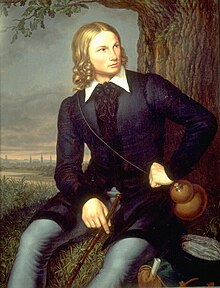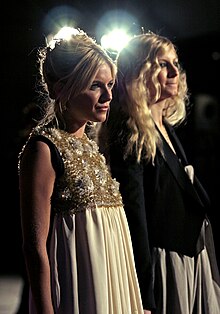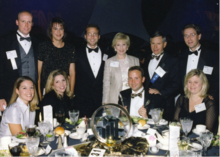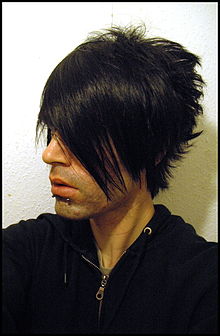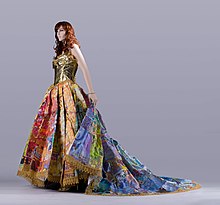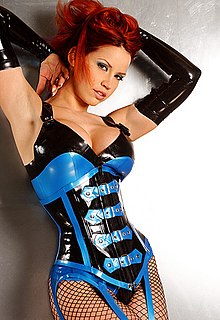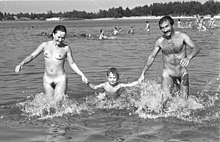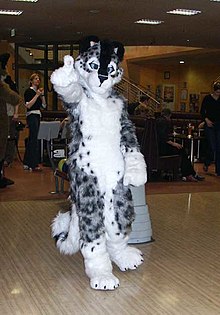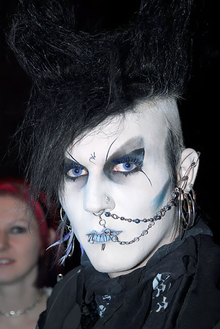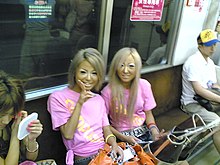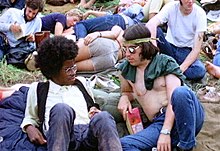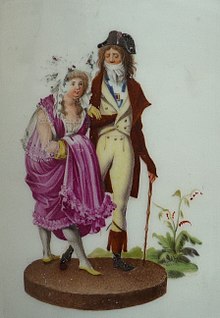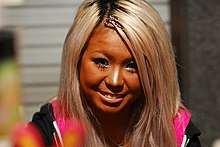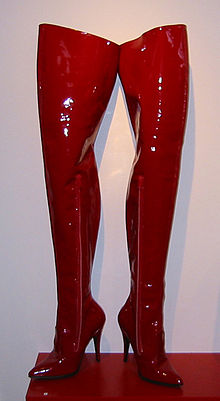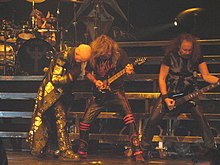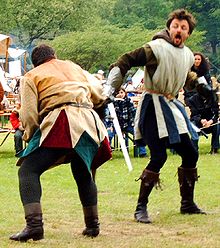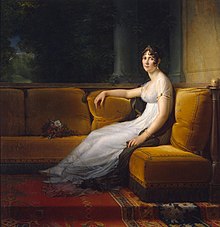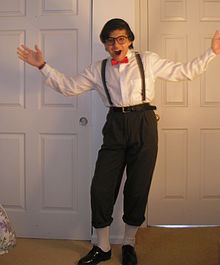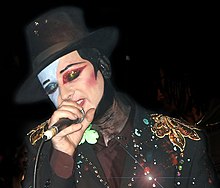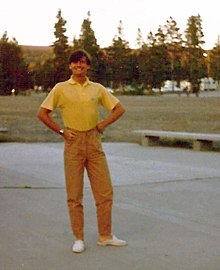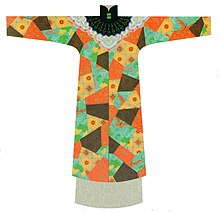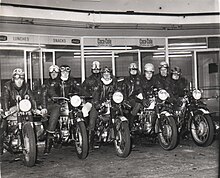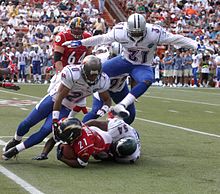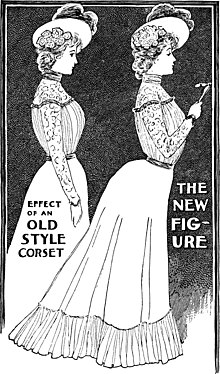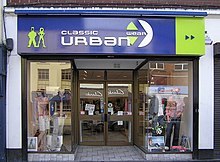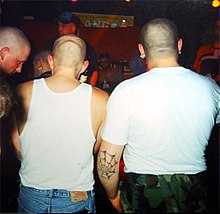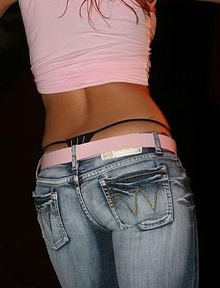List of fashion styles
This is a non-exhaustive list of fashion styles . This list does not contain any fashion by gender ( women's and men's fashion ), by age group ( e.g. baby fashion , children's fashion and youth fashion ), size and location or institution (e.g. school or police fashion ) . Likewise, individual items of clothing should only be mentioned if they represent their own fashion style.
list
| Surname | image | Origin and background | description | Special features |
|---|---|---|---|---|
| Androgyny | Developed as part of women's movements since the 19th century. | Male and female characteristics are united in fashion. | ||
| Anti-fashion |
Examples:
|
Collective term for fashion styles that oppose the current fashion ideal. | ||
| Old German costume | Dress fashion that emerged in Germany between 1813 and 1815 and was very popular with women and men of different social classes during the wars of liberation as an expression of the anti-French German national feeling. This fashion was so provocative and inflammatory that it was partially banned by the authorities during the demagogue persecution, for example in the Karlovy Vary resolutions . | This new fashion should prevail against the still prevailing Empire style, which was called "French fashion folly". The new fashion built on the elements of contemporary fashion and supplemented it with reminiscences of the 16th century , the age of the Reformation and Martin Luther , which was perceived as typically German. | The items added included:
|
|
| Work fashion | Collective term for clothing that is worn at work or as part of a role play. | |||
| African fashion | Collective term for fashion styles in Africa. | |||
| Swimwear | Fashion worn in bathing establishments. | |||
| Blues scene | In the 1960s, the blues in the GDR increasingly gained official recognition. In addition to traditional jazz lovers, young rock enthusiasts also began to take an interest in the blues. The blueser or customer scene reached its peak in the late 1970s. | GDR -specific youth culture or a countercurrent to the "official" youth culture in the GDR. Her guiding principle were the ideals from the western hippie movement such as freedom , authenticity and non-conformism . The scene consisted mostly of young skilled workers, but also high school students and students. This appearance, especially long hair on men and western jeans, often found more conformist people and the police provoked. | Outward characteristics were:
|
|
| Boho chic | Fashion style that is based on various influences, especially the hippies and bohemians , and reached a high point in late 2005 with actress Sienna Miller and model Kate Moss in England (as bobo chic) and with actress and businesswoman Mary-Kate Olsen in the USA was associated. It had been seen since the early 1990s and, although waning at times, reappeared in various guises. Many elements of boho chic were popular in the late 1960s, with some dating much further back and being associated with, for example, the Pre-Raphaelites of the mid and late 19th centuries. | The characteristics of the style included loose-fitting, mostly long and white skirts, fur jackets, embroidered tunics , short-cut jackets, large belts, sheepskin boots and cowboy boots, puffed cardigans and handbags called "hobo bags". | ||
| Bohemian style | 1960s and 1970s | Clothing style that was best known during the 1960s and 1970s, but whose roots go back even further | The essence of the bohemian style is embodied by fluffy and airy fabrics and cuts. In addition, the lovers of this style emphasize that environmental protection is an important concern to them, which is why used second-hand clothes and items of clothing made from natural materials are often worn. | |
| Office clothes | Ended up within the framework of modern bureaucracy . | Fashion style for bureaucratic work. | ||
| Business attire | Developed in the context of economic relationships. | Fashion style for business activities. Mostly indicates more upscale conditions. | ||
| Clubwear | Specific clothing styles that were specially worn by disco or club goers have been around since the disco wave of the 1970s (e.g. Saturday Nightfever). An independent techno-fashion and aesthetic developed since the late 1980s . With the upswing of the techno scene , these styles became increasingly popular in the early 1990s . | English-speaking term for club and disco mode . Disco and club cultures with their own clothing styles and customary dress codes developed . | ||
| Cosplay | Originated in the 1990s with the manga and anime boom in Japan and later spread around the world. | Japanese disguise trend in which the participant depicts a character - from a manga, anime, comic , film or computer game - as faithfully as possible through costume and behavior. | ||
| Cyberpunk and Futurism fashion | Model style devoted to futuristic topics and / or cyberspace . | |||
| Emo | Youth culture and fad emerging since the early 2000s . | The fashion of the emo scene is made up of parts of other scenes. |
|
|
| Ethical fashion | From the late 1980s to the early 1990s | A new term that describes a concept of ethically and ecologically correct industrial clothing production. Similar to social fashion , eco fashion or eco fashion , ethical fashion tries to achieve a symbiosis of fashion with human production and environmental compatibility. | ||
| Extravagant fashion and glamorous fashion | Fashion that is supposed to attract attention by attracting attention through unusual, exaggerated, exaggerated representations. | |||
| Fetish fashion | Mostly clothing in vinyl , latex or leather clothing that is related to fetishism and / or BDSM . | |||
| Nudism | As a countermovement to the tabooing of public nudity in the late 18th century. | Generic term for nude culture , naturism , nudism (for differences see below ) denotes the common nudity of both sexes. | ||
| Furry | The furry phenomenon began in the USA and reached Germany on a larger scale around the mid-1990s | In the fashion term for the disguise as an animal by so-called fursuits . However, fursuiters are only part of furry culture. In German-speaking countries, wearing fursuits is often understood as performance art. |
|
|
| Flapper | The social type of flappers emerged during the American prohibition period , which was largely unpopular in the USA. Following the closure of legal bars and cabarets were speakeasies large inflow of illegal alcohol. The discrepancy between the religiously based and state-supported abstinence policy on the one hand and the actually ubiquitous consumption of alcohol on the other led to widespread contempt for any authority. | In the 1920s, the term flapper referred to young women who wore short skirts and short hair, listened to jazz , and confidently disregarded the rules of good behavior. The Flappers were in her time as a bold and sassy, because they wore make-up, drank hard alcohol and smoking. In addition to their disrespectful behavior, Flappers were distinguished by their fashion, |
|
|
| Gothic fashion | Emerged from the punk and new wave environment in the early 1980s and was made up of several splinter cultures. It existed in the 1980s and 1990s as part of the dark wave movement and formed the hub of the so-called black scene until the turn of the millennium . |
|
||
| Ganguro | Name for mostly teenage girls who follow a trend that first appeared in Shibuya , a youth district in Tokyo . The word is made up of gan , the Japanese word for "face", and kuro , which means "black" in Japanese.
Egg Girls comes from the Japanese girls' magazine Egg , in which you can find all the tips on how to become a real ganguro as quickly as possible . |
|
||
| Girlie | The girlie style developed in isolation and as a break with the then current image of women in the 1990s. | In rejection of the prevailing image of women, adult women appropriate clothing and accessories produced for young girls. The word girlie can also be used to describe a young, girlish and unconventionally dressed woman who appears self-confident, sometimes also cheeky and provocative. |
|
|
| Gyaru | The word spread in the 1970s, but as fashion changed, so did the meaning of the word gyaru. | Japanese transliteration of the English word gal ( phonetic transcription : / gæl /), which means "young woman" and is related to girl (/ gəːrl / jap. ガ ー ル, gāru ). Gyaru denotes fashion-conscious young women or representatives of a Gyaru-specific fashion type and in this sense is partly congruent with Kogyaru . The features of gyaru fashion are eye-catching makeup and hairstyle. | ||
| Hippie fashion | Originated in the USA in the 1960s and is based on the previously known hipster style . | Countercultural youth movement of the 1960s. |
|
|
| Hip-hop fashion or street fashion | Has origins in the Afro-American ghettos of New York City in the 1970s and has meanwhile developed into a global subculture of urban youth ( youth culture ). | As in other youth cultures, there is a special fashion in the hip hop subculture. Hip-hop and its fashion are, like many other youth cultures, male-dominated. | Hip-hop fashion lives from extremely wide cuts in trousers and tops. The entire appearance is lush, with lots of massive emblems and eye-catching details. In addition to jeans, a large number of items of clothing borrowed from the sports sector are worn. Examples:
|
|
| Hipster fashion | early 21st century | Referred widespread in the early 21st century in the media, mostly somewhat derisively used name for a milieu whose members their scene awareness - in contrast to the mainstream - extravagant express. Most of them are young people to young adults of the urban middle class . The name is borrowed from the avant-garde subculture of the same name of the mid-20th century . One sees oneself as a subculture , but is now more of the mainstream. | ||
| Incroyables and merveilleuses | As part of the freedoms after the French Revolution . These were used by a class of the nouveau riche to appear through particularly eye-catching clothing. They exaggerated their fashion, even their pronunciation, so much that all of Paris laughed at them and ridiculed them with satirical writings, songs and caricatures. | Parisian citizens who dressed extremely conspicuously during a brief period of the French Revolution .
As blonde wigs were previously banned, they now wore them as a special expression of their anti-attitude. They called themselves Incroyables et les Merveilleuses. |
||
| Jeans fashion | Collective term for fashion with a jeans look | |||
| Chain layering | Chain layering has its origins in the punk scene of the early 1980s. It made its comeback in 2014 . In the years that followed, well-known fashion magazines such as the German Vogue , Elle and InStyle presented chain layering as an important jewelry trend for the respective fashion season. | Trend in which mainly chains of different lengths are combined with one another.
There is basically only one rule for chain layering: The chains combined with one another must have different lengths. Almost all types of chains are allowed: from chokers to extra long chains that reach down to the navel. The trend to wear several similar pieces at once exists in the fashion world under the term layering look or layered look. |
||
| Clothing in the stone age | Clothing worn in the Stone Age and early human history. | |||
| Clothing in ancient times | Fashion worn by the Romans, Greeks, Egyptians or other ancient high cultures. | |||
| Clothing fashion from the Wilhelminian era up to 1900 | In the second half of the 19th century , overall fashion expenditure decreased. Instead, rapid and arbitrary change began in the early years after the Franco-German War of 1870–1871. | Wide and tight, long and short skirts, high and low hairstyles, big and small hats came and went. | ||
| Renaissance and Reformation clothing fashion | The 16th century, the age of the Renaissance and the Reformation and the time of spiritual change, also brought about a change in costume. | The costume should no longer enclose the body tightly, but allow comfortable movement and, in contrast to earlier times, appear free and dignified at the same time.
The model was the traditional dress of the Landsknechte with its features of slitting and feeding. The main items of clothing for men around 1530 were doublets , trousers, scarfs and berets . |
||
| Clothing fashion of the restoration and the Biedermeier | During the time of the so-called restoration , the view of women's fashion also changed, and from around 1820 a return to old forms began. | |||
| Kogal | a subculture of girls and young women in Japanese metropolitan areas that emerged in the 1990s . | It is defined by the consumption of validity, i.e. the demonstrative display of available income through particular musical tastes, clothing and social behavior. In Japanese society, this subculture is viewed as gross and tasteless. The girls refer to themselves as Gyaru ( gal ), although this also includes other related subcultures. | ||
| Crinoline fashion | From 1842 to around 1870 is to be regarded as a continuous epoch, the beginning of which is marked by the introduction of the crinoline . The petticoat initially consisted of fabric reinforced with horsehair and replaced the previously common wearing of several fabric petticoats. This gave the skirt a dome shape, which determined fashion until the 1860s. | |||
| Lolita fashion | While the exact origins of Lolita fashion are unclear, it is likely that the movement started in the late 1970s when famous labels like Pink House , Milk and Pretty (later known as Angelic Pretty ) started making Lolita-style clothing for sale. Shortly afterwards, labels like Baby , The Stars Shine Bright and Metamorphose temps de fille were added. | Is a Japanese fashion style based on the Victorian style and clothing from the Rococo , but has evolved far beyond these two. | * Lolita fashion is characterized by puffy skirts or dresses supported by petticoats, often adorned with ruffles and lace .
|
|
| Lacquer clothing | Collective term for clothing made of paint. | |||
| Leather clothing | Collective term for clothing made of leather. | |||
| Latex clothing | Collective term for clothing made of latex. | |||
| Metal fashion | Fashion worn by metal followers. | |||
| Metrosexuality | The term metrosexual was first published in 1994 by British journalist Mark Simpson . | Extravagant lifestyle of heterosexual men who do not value categorization in a masculine role model. | ||
| Military look | Refers to a fad in which civilian clothing is combined with military clothing or in which civilian clothing is usually given a military look through real or simulated camouflage printing . The best-known examples of military-style clothing in Germany include the MA-1 bomber jacket , the CWU-45 / P flight jacket , the Bundeswehr parka , various US field trousers and the M-65 US field jacket . | |||
| Medieval fashion | Since the Middle Ages | Fashion worn in the Middle Ages and the Middle Ages scene. | The differences between the stands were mostly only in the material used and the associated decorations. The materials available for making textiles for the lower classes were linen , hemp , nettle (these three especially for use in underwear) and sheep's wool (these especially for outerwear). The higher class could also fall back on expensive imported fabrics made of silk and generally used better textile qualities and refined cloths . | |
| Fashion à la grecque | From 1794 to 1811 in the Directoire and Empir | In the fashion of the Directoire and Empire (i.e. in the period from 1794 to 1811), women’s fashion is very much based on ancient models.
Although they spoke of nude fashion , they actually wore undergarments or, especially in France, flesh-colored jerseys . |
Characteristic are chemise , shirt dresses from almost transparent muslin with a very high fixed waist, a revealing neckline and short sleeves. Since muslin or the seldom used silk were very expensive fabrics, the fashion was limited to wealthier circles. | |
| Fashion in islam | Fashion style in the Islamic faith and also in countries that are shaped by Islam. | |||
| Fashion in National Socialism | Time of National Socialism | Prescribed fashion style for men and women under National Socialism . | ||
| Nerd , geek and fan fashion | Fashion term for the clichéd appearance of a nerd, geek or a fashion related expression of belonging to a fan culture. |
|
||
| New look | Postwar period and especially the 1950s | Describes the prevailing style in women's fashion in the post-war period and especially in the 1950s. | Characteristic was a narrow waist and narrow shoulders - thus an emphasis on the breasts - as well as a wide, calf-length skirt . | |
| New Romantic | Music and fashion wave that was popular from around 1978 to 1982. It originated in the UK and was viewed as a predominantly British phenomenon as part of the earlier New Wave . | The fashion wave was essentially limited to the external appearance, consisting of clothing, hairstyle and cosmetics. In general, New Romantic has also been associated with music. | ||
| Normcore | Since the late 2000s | Unisex - fashion trend , which is characterized by inconspicuous, average clothing. The term is a suitcase word from the English words normal and hardcore (German literally "hard core"), and was coined by a US marketing agency. | Normcore dresses are everyday casual items of clothing such as T-shirts , short-sleeved shirts, hoodies , jeans or chinos . These dresses are worn by men and women alike. Elements such as ties or blouses are not part of the normcore style. | |
| Nude look | The development of this “up close” fashion trend goes back to the French boudoir style at the turn of the century (19th / 20th century), when sometimes frivolous, often transparent underwear fashion with deep necklines , lots of lace , romantic ruffles , folds and fluttering flounces emerged established for domestic use in middle-class circles. The production of the necessary materials was made easier by automation in the textile industry - so-called jacquard fabrics suddenly became affordable for many. | A trend in fashion in which fabrics, contours, proportions and cuts show more nudity and body details than conceal and emphasize the narrow silhouette, for which materials such as silk , tulle , voile , muslin , batiste , satin , organza , lycra , nylon , taffeta or chiffon are most popular become. | ||
| Fur fashion | Clothing and accessories made from processed hides (fur) | |||
| Preppy | Since the 1980s | In the English-speaking world, students or graduates of a well-known secondary school (" Preparatory School ") who come from affluent parents, who often belong to the so-called WASPs , are more conservative and who maintain a corresponding lifestyle. The Ivy Look from the 1960s is at the same time a fashion direction of the Preppy style that originated in the universities of the Ivy League in the northeastern United States. | The basic styling rules are reminiscent of the popper style of the 1980s. Polo shirts , tweed suits , blazers in school uniform -Look, Cordjacken with elbow protectors, button-down shirts, chinos and loafers among them just as monograms and coats of arms, horn-rimmed glasses , chronograph and narrow belt as accessories . For example, design elements from sailing fashion are combined with classic British (Scottish) patterns (checked, stripe and diamond patterns, called argyle patterns ); the materials are high quality and exclusive (for example cashmere wool ). | |
| Popper | The youth movement spread in 1979, starting from high schools in Hamburg , during the first half of the 1980s. | Members of a German youth culture in West Germany , West Berlin and the GDR in the first half of the 1980s . In Austria they also called themselves snobs . |
|
|
| Punk fashion | Since the 1970s in the Anglo-American region as part of the punk movement. | Although punk as an idea stands up against norms and for individuality, a typical appearance has emerged since the 1980s that prevails within the scene, even if it is by no means mandatory. The clothing of early British punks was an expression of the rejection of mainstream and hippie culture and was characterized by the fact that normal everyday objects were misappropriated and used as clothing and jewelry (e.g. safety pins or dog collars), and thus represented an anti -Fashion. In the early years 1976/77, punks wore tattered suits with safety pins and badges, plus creepers , eye-catching socks and sunglasses. Swastikas were also often used for provocation, especially by the previous generation. Individual, self-designed T-shirts, often torn, or strikingly designed shirts were worn under the jacket. | ||
| Rice field | The shapes of the rice fields were integrated into their fashion creations by early Chinese “fashion designers” in the Tang and Ming periods. At that time so-called rice field clothes were created; Costumes composed of many pieces of woven brocade. | Design style inspired by the different geometric shapes of the rice fields (triangular to square, diamond to rectangular). | ||
| Retro wave | Fashion wave , the content of which is a backward-oriented fashion . The expression retro ( lat. Retro backwards) in many areas denotes phenomena that are linked to older traditions or characteristics. | |||
| Revolutionary and empirical fashion | Successor fashions of Rococo and include a third style, the Directoire . The revolutionary fashion lasted from 1789 to 1795, the Directoire covered the period from 1796 to 1804 and was then replaced by the Empire fashion , which ended in 1820. | These clothing epochs were, like the politics of that time, exceptionally short and fast-paced, did not flow into one another and sometimes ended abruptly from one year to another. | ||
| Rockabilly | It originated in the mid- 1950s when young, mainly white musicians in the American southern states reinterpreted black rhythm & blues in their own way and with familiar instruments and mixed it with country music . | The term rockabilly, which was originally only used for a certain type of music, has been expanded and also refers to certain hairstyles, jewelry and clothing that take up or even copy what were perceived as characteristic and actual style features of the 1940s and 1950s. Rockabilly fans fall back on the great stylistic range of these decades. |
|
|
| Rocker clothing | 1960s | (Youth) subculture , mainly with passionate motorcyclists is associated | British rockers show distinctive clothing ( leather jackets , jeans ) and a penchant for rock 'n' roll and rockabilly . | |
| Rococo clothing fashion | Similar to the architecture of this epoch, it is considered a continuation of the Baroque and is generally dated from around 1720 to 1770, and in some cases to the outbreak of the French Revolution in 1789. The main starting point for fashion development was the French royal court in Versailles until around 1760 oriented the fashion in the whole of Europe. | |||
|
Romantic look
(also princess style) |
The romantic look is related to the retro look . In Germany in 2005/2006 a popular telenovela entitled Sophie - Bride against Will brought the “princess style” to the general public as an homage to fairytale dresses, hairstyles and sweet pastel colors as well as old-fashioned floral decorations. | Design direction in women's fashion , in which playful, "sweet" and fairytale elements are emphasized, the romantic mood (the so-called "ideal world"), innocence and seduction should be stylized. |
|
|
| Alluring and erotic fashion |
Garments that can serve the sexual partners to excite sexually or even their own vanity to satisfy. This is in particular clothing from the area of underwear , which is often specially made from materials that are perceived as erotic and are usually not used in the area of functional underwear, for example velvet , lace , lycra or satin . This effect is also underlined with special cuts. Lingerie and lingerie are available for both women and men, although the range for women is significantly more diverse and extensive. Often more elegant and high-quality processed laundry items are referred to as lingerie, while more provocative laundry, especially in certain colors such as black or red, is more likely to be referred to as lingerie.
Clothing for erotic role play also falls under erotic fashion. |
|||
| Seapunk | As a trend on the Tumblr website since 2011 . | Fashion style based on water themes. |
|
|
| Steampunk | First appeared as a literary movement in the 1980s and later became its own art style and subculture. | Steampunk fashion is essentially based on the fashion styles of the Victorian Age , which makes it very similar to Japanese Lolita fashion . These are also available in a steampunk version. In addition, cowboy clothing , Gothic fashion and regional costumes also exert a certain influence. This is always supplemented by elements that come from steampunk fiction. This can e.g. B. be a cell phone or a steampunk-style camera. | ||
| Sportswear | Fashion that is worn during exercise. | |||
| Sans Ventre Line | around 1900 to 1906/1907 | Tight, stiff corset ( sans-ventre corset ) achieved a body shape that made the belly disappear visually ( sans ventre , French for “without belly”), pushed the hips backwards and gave the body an S-shape when viewed from the side (hence also S-corset or S-line corset ) and an always slightly bent posture. | ||
| Black scene | The black scene emerged at the end of the 1980s from the independent environment of the 1980s with various subcultural groups whose musical core was post-punk , post-industrial and dark wave . In this first loose network, the Gothic scene , Waver , EBM followers , the Neofolk scene as well as followers of the different post-industrial forms operated. | Fashion style that is very much influenced by the color black. | ||
| Bell costume | Has been worn by noble people since the 10th century and also appeared in the cities in the second quarter of the 14th century and was maintained until well over the middle of the 15th century despite all the luxury laws . | A trumpet costume common to both men and women . d | ||
| Silhouette (fashion) | Fashion style for dresses. |
|
||
| Spanish clothing fashion | Fashion of the late Renaissance and Spanish Baroque, the period between 1500 and the Thirty Years War . It was shaped by the idea of the Counter Reformation , the movement with which the Catholic Church and the Catholic-led states, including Spain, fought the Reformation . At the Spanish, as well as at the Viennese court, the Spanish court costume was ceremonial up to the high baroque ( Spanish court ceremony ). |
Man:
Woman:
|
||
| Streetwear | Term for certain types of urban, often more “youthful” casual clothing. The term is used by the clothing or lifestyle -Industrie often than marketing - word used and immersed in the German language in different contexts sometimes used interchangeably, sometimes as distinct from various also of the English language borrowed words such Skatewear , Sportswear , Club Wear , Street fashion , Urban wear , urban clothing or street style . Due to the wide range of uses, an exact definition is difficult. |
|
||
| Swingers (fashion) | a wide cut, usually ruffled at the collar height and / or at the base of the sleeves, up to 100 centimeters long, short coat in A-line with a bell-shaped back, also as a summer coat . | |||
| Skinhead | At the beginning of the 1970s, when long hairstyles were fashionable, a short hairstyle in which the scalp shines through. | Collective term for all members of the skinhead scene |
|
|
| Techno fashion | During the 1990 year | Subculture around techno music in the narrower sense and electronic dance music in the broader sense |
|
|
| Travesty fashion | Fashion worn by people who are of a different sex than for whom the fashion is intended. Sometimes extravagant and exaggerated as part of a show act. | |||
| Tomboy fashion | Girls and women who behave contrary to the usual gender roles like boys or men. | Girls and women who wear more masculine clothes. | ||
| Uniform fashion | Uniform fashion style, which is prescribed as a dress code in schools or in the military, for example. | |||
| Vintage fashion | In fashion , vintage is understood to mean a piece of clothing from an older collection by a designer . The term is probably derived from its use in oenology , where vintage refers to the year or harvest of a wine. | |||
| Quadruple costume | Was worn by West Germanic women between the 5th and 7th centuries. | Early medieval clothing style that was worn by West Germanic women between the 5th and 7th centuries. This costume owes its name to the fact that it was usually worn with two pairs of fibulae, which differ in shape . |
|
|
| Verdugado | The origin is in Spain around 1470, where the so-called “Verdugado” was worn as part of the outer clothing. Rings made from subtropical pile tubes or Spanish reeds were initially used for support and were later replaced by willow rods and wire frames. | Historical Spanish name for a medieval petticoat, originally made of wicker. Even if the shape looks like the newfangled hoop skirts , the construction is different. | ||
| Whale tail | The word was created by the American Dialect Society (a learned society ) in January 2006 voted "most creative word" of 2005. The term finds its way into the German-speaking world via websites with pictures and blogs . | Designation for one over the waistband of the pants , the shorts or the Rocks also standing Thong or string , the resemblance to a standing out of the water tail fin of a whale has | ||
| Western fashion | Fashion that is based on the clothing of a cowboy . |
|
||
| Winter fashion | Special clothing for winter with the purpose of providing warmth. | For example, hats , scarves , coats , furs or padded jackets are used here. For individual winter sports (e.g. ski fashion) there are usually other accessories . | ||
| Zatteltracht |
|
A fashion that emerged in the 13th century, in which the male clothing was cut into long spikes or stripes (so-called saddles) or studded with saddles. |
|
|
| Zettai Ryōiki | The term itself comes from the 1995 anime series Neon Genesis Evangelion . | Clothes combination of mini skirt or shorts and knee - stockings . | Clothes combination of mini skirt or shorts and knee - stockings . |
See also
literature
- Alfons Hofer: Textile and Fashion Lexicon, Deutscher Fachverlag, 1997
- Julia Bertschik: Fashion and modernity: clothing as a mirror of the zeitgeist in German-language literature (1770-1945), Böhlau Verlag Cologne Weimar, 2005, ISBN 978-3-412-11405-3
Individual evidence
- ↑ Malcolm Barnard: Fashion as Communication . Psychology Press, 2002, ISBN 978-0-415-26018-3 ( google.com [accessed April 2, 2018]).
- ↑ Fashion in Africa: Fashion as a means of self-presentation and expression of modernity . Museum für Völkerkunde, 2005 ( google.de [accessed April 2, 2018]).
- ↑ Have a bohemian style . In: wikiHow . ( wikihow.com [accessed April 2, 2018]).
- ↑ Office clothing - dress codes for women and men. Retrieved April 2, 2018 .
- ↑ Business attire : This is what dress codes mean for men. Retrieved April 2, 2018 .
- ↑ Valerie Steele: Fetish: Fashion, Sex and Power . Rowohlt, 1998, ISBN 978-3-499-60483-6 ( google.de [accessed April 2, 2018]).
- ↑ Doris Schmidt: Clothing from the Stone Age to the Early Middle Ages . Schneider-Verlag Hohengehren, 1992, ISBN 978-3-87116-559-7 ( google.de [accessed on April 2, 2018]).
- ↑ clothing | Stone newspaper. Accessed April 2, 2018 (German).
- ↑ Stone Age live in class: making clothes, food, tools and jewelry yourself; (for children from 8 to 12 years) . Care-Line, 2001, ISBN 978-3-932849-50-3 ( google.de [accessed April 2, 2018]).
- ^ Emil Hoffmann: Lexicon of the Stone Age . BoD - Books on Demand, 2012, ISBN 978-3-8448-8898-0 ( google.de [accessed April 2, 2018]).
- ↑ Doris Schmidt: Museum and textile lessons: clothing in antiquity. - 1st Greeks . Schneider-Verlag Hohengehren, 1992, ISBN 978-3-87116-556-6 ( google.de [accessed on April 2, 2018]).
- ↑ Angelika Starbatty: Appearance is a matter of opinion: clothing in communication in Roman antiquity . Herbert Utz Verlag, 2010, ISBN 978-3-8316-0927-7 ( google.de [accessed on April 2, 2018]).
- ^ Magdalena Craciun: Islam, Faith, and Fashion: The Islamic Fashion Industry in Turkey . Bloomsbury Publishing, 2017, ISBN 978-1-4742-3438-2 ( google.de [accessed April 2, 2018]).
- ↑ Felicia Englmann: Book about Islamic fashion: clothes make the man, veils make women . In: FAZ.NET . October 18, 2017, ISSN 0174-4909 ( faz.net [accessed April 2, 2018]).
- ^ Pepin van Roojen: Islamic Fashion & Dress - Clothing and fashion in Islam . Pepin Press, 2012, ISBN 978-94-6009-008-0 ( google.de [accessed April 2, 2018]).
- ↑ Paul Dahms: Mode in National Socialism: between ideology and management of the shortage . Books on Demand, 2012, ISBN 978-3-8482-0666-7 ( google.de [accessed April 2, 2018]).
- ↑ Ursel Fritzle: Lerncafe - Mode in National Socialism. Retrieved April 2, 2018 .
- ↑ Patrick Guyton: Cultural History of Fashion: The Nazis New Clothes . In: The daily newspaper: taz . May 16, 2017, ISSN 0931-9085 ( taz.de [accessed April 2, 2018]).
- ^ Miles Raymer: The week seapunk broke . In: Chicago Reader . ( chicagoreader.com [accessed April 2, 2018]).
- ^ Daniela Mauch: On the differentiation of sports fashion: a system-theoretical investigation . Schneider-Verlag Hohengehren, 2005, ISBN 978-3-89676-896-4 ( google.de [accessed on April 2, 2018]).
- ↑ Heike Stemmler: Winter fashion: on Barbie's, Karina's u. Tailored to Petra's size . Frech, 1987, ISBN 978-3-7724-1111-3 ( google.de [accessed April 2, 2018]).

